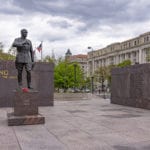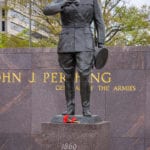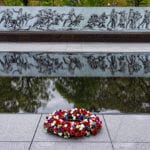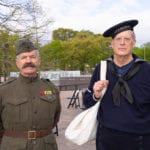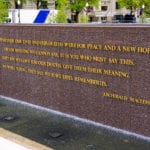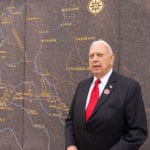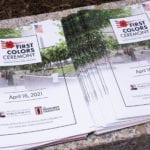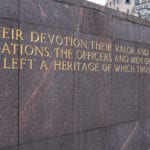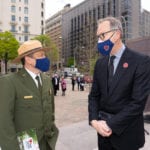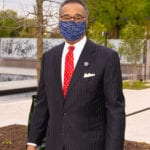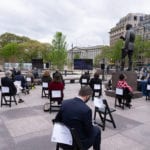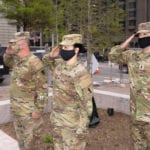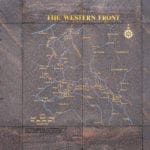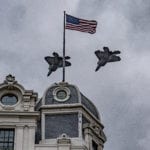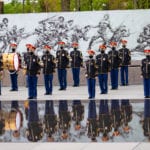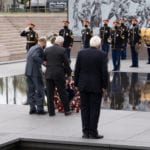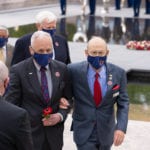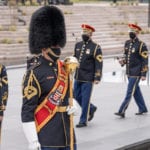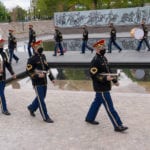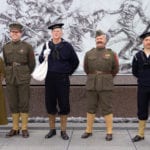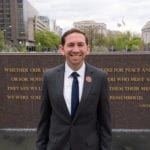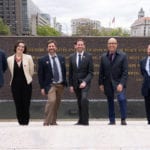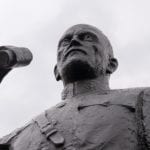National World War I Memorial Opens in D.C. (photos)
By • April 17, 2021 0 5540
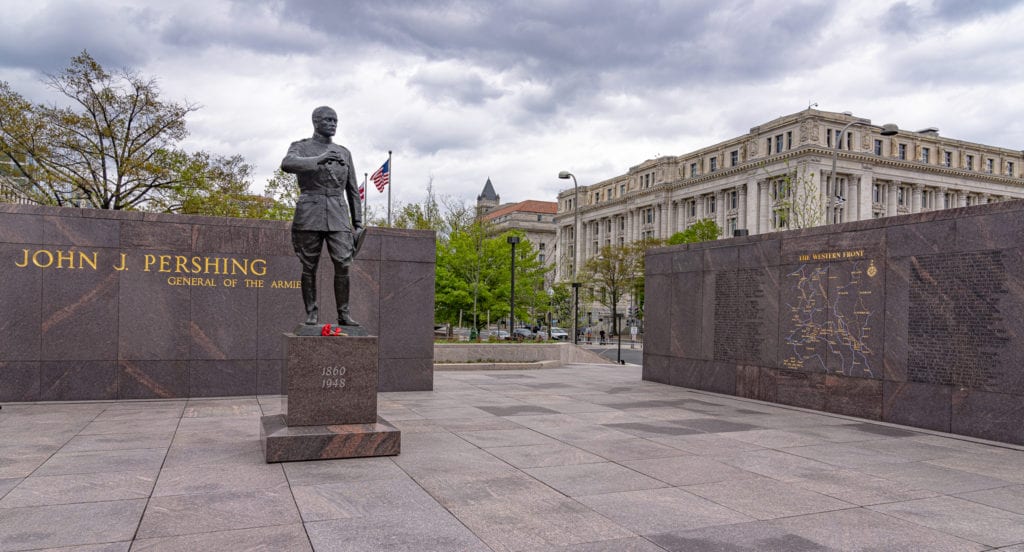
The District welcomed its newest national monument on Friday, April 16, with a solemn ceremony and a flag raising. The National World War I Memorial, located on Pennsylvania Avenue NW, is now open to the public.
The memorial, which features sculptures, fountains and quotes, honors the 4.7 million Americans who served in uniform, including 117,000 killed, as well as the civilians who served on the home front, in what was at the time called the Great War.
The National World War I Memorial occupies Pershing Park at 14th Street and Pennsylvania Avenue NW, just one block from the White House. The 1.8-acre park is named for John Joseph “Black Jack” Pershing, who commanded the American Expeditionary Forces in Europe. Pershing is the only American to be promoted in his own lifetime to General of the Armies, the highest possible rank in the U.S. Army. The new memorial incorporates an eight-foot-tall statue of Pershing by Robert White, dedicated in 1983.
The “First Colors Ceremony” featured opening remarks from President Joe Biden, delivered by telescreen, and a flyover by a pair of F-22 fighter jets from the U.S. Air Force 94th Fighter Squadron. British Ambassador to the U.S. Dame Karen Pierce and British Defence Attaché Air Vice-Marshal Mick Smeath, RAF, were in attendance. A memorial wreath was jointly placed by World War I Centennial Commissioner and Vietnam War POW Col. Thomas Moe, USAF (Ret.), and Chairman Jerry L. Hester. The United States Army Band “Pershing’s Own” provided musical accompaniment.
World War I began on July 28, 1914, and ended on Nov. 11, 1918, at the 11th hour of the 11th day of the 11th month. Congress didn’t declare war on Germany until April 6, 1917, but America’s entry proved decisive in turning the tide in favor of the Allies. In conjunction with the upcoming WWI Centennial, the 2015 National Defense Authorization Act authorized the World War I Centennial Commission to build the memorial. Congressional sponsors Rep. Emanuel Cleaver (D-Missouri) and former Rep. Ted Poe (R-Texas) participated in Friday’s opening ceremony.
Work on the project began much earlier, according to Edwin Fountain, the commission’s vice chair, who was there at the start in 2008. It had been “thirteen years from the first idea to completion,” said Fountain. “It was a disservice that we had national memorials to the three other major wars of the 20th century but not one to World War I. And now those veterans are honored in the same way that the veterans of those other wars are.” Both of Fountain’s grandfathers were in the Army at the time. “What I am proud of … is that each in his own way represented a different part of the American Experience,” he said. One was a “farm boy who hardly had ever been outside the county he grew up in before he went to France” and the other was a recently arrived immigrant.
“This will be our 32nd battle monument,” said retired Maj. Gen. William M. Matz Jr., outgoing secretary of the American Battle Monuments Commission, which will manage and take over the monument for the National Park Service.
Construction is now complete, with the exception of “The Weight of Sacrifice” by Chicago architect Joe Weishaar and New York sculptor Sabin Howard: a 65-foot-long, 10 1/2-foot-high bronze wall covered with bas reliefs comprising 38 different figures, currently being worked on by Howard. Until it is finished, in 2024 or 2025, visitors will view a temporary canvas anticipating the artwork to come. In a series of images from left to right, the reliefs will depict in sequential fashion the stages of a soldier’s journey, from his departure to the battlefield through his return home. To aid in the construction of the clay model, Howard incorporated state-of-the-art 3D imaging techniques using real-life models.
The memorial design includes a Peace Fountain inscribed with a quote from American poet Archibald MacLeish, who saw action in the conflict. The design team included GWWO Architects of Baltimore as architect of record and Land Collective of Philadelphia as landscape architect.
“This memorial finally will offer a chance for people to visit and reflect and to remember. More than 100 years has passed since World War I ended, but the legacy and courage of those doughboys, sailing off to war, and the values they fought to defend still live in our nation today,” said President Biden.
View Jeff Malet’s photos of the National World War I Memorial from the “First Color Ceremony” on April 16 by clicking on the photo icons below.
- The new memorial features sculptures, fountains and quotes which pay tribute to those who served in World War I. Phoro by Jeff Malet.
- The new memorial features sculptures, fountains and quotes which pay tribute to those who served in World War I. (photo by Jeff Malet).
- The new memorial incorporates an 8 foot tall statue of Pershing by Robert White dedicated in 1983. (photo by Jeff Malet).
- Re-enactor Tom Frezza as a sailor of the USS Olympia and sea dog Shea (photo by Jeff Malet).
- “The Weight of Sacrifice” The intention for the artwork is to educate the public and to commemorate those who served in the war. (photo by Jeff Malet). (photo by Jeff Malet).
- British Ambassador to the U.S. Dame Karen Pierce and the British Defence Attache Air Vice-Marshal Mick Smeath, RAF. (photo by Jeff Malet).
- WWI Re-enactors Mark Ragan as a First Sergeant U.S. Marines, and Peter Tuttle as a sailor of the USS Olympia (photo by Jeff Malet).
- Quote from the American poet Archibald MacLeish, who saw action in the conflict
- Edwin Fountain (Vice Chair), Terry Hanby (Chair), Dan Dayton (Executive Director) (photo by Jeff Malet).
- Former Rep Ted Poe (R-Texas) was a key sponsor in Congress (photo by Jeff Malet).
- Retired Maj. Gen. William M. Matz, Jr., outgoing secretary of the American Battle Monuments Commission (photo by Jeff Malet).
- Each guest received a program. (photo by Jeff Malet).
- World War I re-enactors from York Pa. are Gabrielle as a “Donut Dolly” and Chris as a Marine of the 2nd Division. (photo by Jeff Malet).
- The Memorial which features sculptures, fountains and quotes, honors the 4.7 million Americans who served in WWI (photo by Jeff Malet).
- Jeffrey P. Reinbold, National Park Service Superintendent of National Mall; and Memorial Parks talks to Chirs Islieb, Director of Public Affairs, United States World War One Centennial Commission. (photo by Jeff Malet).
- Rep. Emanuel Cleaver (D-Mo.) was instrumental in providing Congressional support (photo by Jeff Malet).
- Meredith Carr is Deputy Director of the World War I Centennial Commission. She was the first employee of the Commission. (photo by Jeff Malet).
- Attendees to the ceremony sat at a safe 6 feet apart. (photo by Jeff Malet).
- (photo by Jeff Malet).
- The intention for the artwork is to educate the public and to commemorate those who served in the war. (photo by Jeff Malet).
- National Guardsmen from Missouri stop by to pay respects. (photo by Jeff Malet).
- The Memorial which features sculptures, fountains and quotes, honors the 4.7 million Americans who served in WWI (photo by Jeff Malet).
- F-22 fighter jets, symbolically piloted by American and British Pilots, fly over the Willard Hotel. (photo by Jeff Malet).
- The U.S. Army Band “Pershing’s Own” and color guard. (photo by Jeff Malet).
- A memonial wreath was jointly placed by WWI Centennial Commissioner Vietnam War POW Col. Thomas Moe, USAF (Ret.), and Jerry L. Hester. (photo by Jeff Malet).
- A memonial wreath was jointly placed by WWI Centennial Commissioner Vietnam War POW Col. Thomas Moe, USAF (Ret.), and Jerry L. Hester. (photo by Jeff Malet).
- The U.S. Army Band “Pershing’s Own” (photo by Jeff Malet).
- The U.S. Army Band “Pershing’s Own” (photo by Jeff Malet).
- World War I re-enactors. (photo by Jeff Malet).
- Chicago architect Joe Weishaar. (photo by Jeff Malet).
- The design team, Ryan McCloskey, Gabriella Salvemini, Brian Weisgerber, Joe Weishar, David Ruben and John Gregg, (photo by Jeff Malet).
- The new memorial incorporates an 8 foot tall statue of Pershing by Robert White dedicated in 1983.

